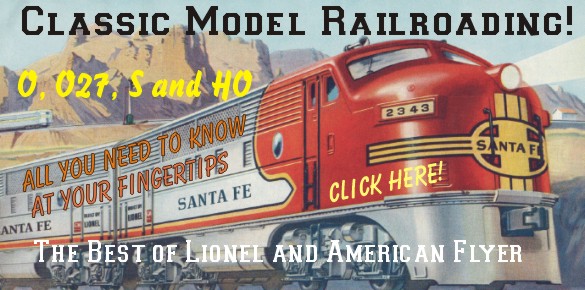
Copyright 2001 T. Sheil & A. Sheil All Rights Reserved
How to learn about your trains, what type they are, and how to run them
It happens....you find a box of old trains. Whether they were up in the attic, at a flea market or passed off to you by a relative, you;re looking at a confused mass of trains, track, wires and odd pieces. What do you have, and how do you make sense of it?
Time for you to learn what's in that box!
In order to do this, you are going to need some household tools. First and foremost is a ruler or measuring tape. That is probably the most important thing you will need. If you have wire, all for the good. 18-gauge wire is preferred. (Note that with wire, the higher the gauge number, the thinner the wire. Though you can use 24 gauge for electric trains, 18 is preferred. Screwdrivers with small heads will help. Have on flat head and one Philips head handy. I recommend a needle-nose pliers, too. The extra reach is a plus. Once you find out what you have, you'll need the screwdrivers, wire and pliers to set it up.
Many people believe that trains similar to their old ones are no longer made. Actually, almost every major (and minor) scale is in current production. You can find reasonably-priced replacement parts, track, transformers and cars for all G / #1, O, S, HO, N and G trains. This includes Lionel, Marx, and American Flyer trains. It may take a little extra effort for TT and OO, but there are resources out there!
Track: you probably have track of a single type in the box, but there are occasions where everything got thrown together. You might have several sizes in there. Separate by size and type as much as possible.
Does your track have two or three rails?
Is it solid or tubular?
Measure the distance between the outer rails. Here are the sizes you are most likely to encounter:
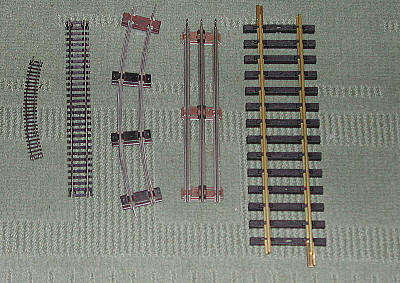
From left to right, smallest to largest, the track types shown are N, HO, S, O, and #1. (#1 is also known as G) N, HO and #1 are solid; S and O are tubular. The O track illustrated here has three rails.
2 1/8": Standard or Wide Gauge
1 3/4": #1 Gauge / G Scale
1 1/4": O Gauge
7/8": S Gauge
3/4" - 19mm: old American OO
5/8" - 16.5mm: HO Gauge
15/32 inch, about one half inch: TT Gauge
3/8" - 9mm: N Gauge
If you have O Gauge with three rails, you must measure something else. The height of the track tell us more information:
7/16" to 1/2": O27
13/16" to 3/4": O Gauge
Measure the length of a straight three-rail track. Standard O27 is 8 3/4" to 8 7/8" long Standard O is 10 inches. Marx O27 is also 10 inches.
Don't worry if your measurements are off a hair.
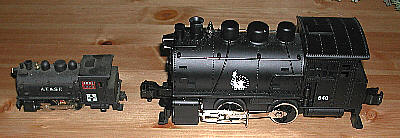
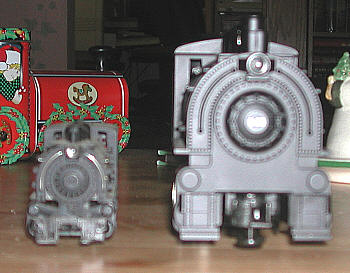
These illustrations show the size difference between HO on the left and O on the right. Both are models of the Docksider 4-wheel steam locomotive.
What gauge are your trains?
Measure from the flange of one wheel to another. Compare to the track sizes above. The track size that is closest is the right one.
If your trains are S Gauge by American Flyer, or if they are O, OO or S and have three rails, they are AC-powered. Most two-rail trains are powered by DC. #1 / G, HO, TT, N and O Gauge with two rails are DC. O Gauge with three rails is AC.
What if you have both two-rail and three-rail O in the box?
Three-rail locomotives have an electrical pickup in the center between the wheels. It will either be a roller or a flat copper shoe. Two-rail locomotives have no pickup.

Here you see a center-rail pickup, in this case rollers, in the O locomotive on the right. The HO locomotive on the left has no center pickup. Some O trains have a flat, long copper shoe as a pickup, instead of rollers.
Sort by Brand: Some names are famous, and denote peculiar characteristics that make their trains unique. Once you know the size of your trains, you can learn how to use them:
O Gauge:
Lionel: the most famous of the lot. Pre-1942 Lionel uses a weird type coupler, and usually has cars made of tinplate steel. Post-1945 trains have mainly plastic cars and a knuckle-type coupler. (Only the Scout sets from the late 1940s have an odd coupler. The rest of Lionel Post-1945 is pretty much standard) To use Lionel trains and equipment, follow this link. Everything you need is included, as this is a starter manuals for Lionel trains and accessories. Note that a rare few Lionel O sets were made for DC. These were made after 1970, and they use a very small and cheap locomotive. Everything else was AC.
American Flyer: The O Gauge train were made prior to 1942. They run like Lionel, but there are differences. Try our basic manual. For more detailed information, try the American Flyer collector websites.
Marx: one of the most prolific train makers. Marx trains are much like Lionel, but they have different couplers. Older locomotives have a "fat wheel" which makes them unable to use Lionel-type switches and crossovers. Try this link to learn more about enjoying your Marx trains. Note that the Marx Lehigh Valley red switcher, #112, is made or DC power! All the rest are AC.
American Model Trains (AMT) / KMT / Kusan: this competitor to Lionel made two-rail trains. They are very uncommon. Cars are usually compatible with Lionel, but the locomotives are not. Go to AMT / KMT collector sites to learn more.
Colber: This company made accessories for Lionel and Marx trains. They are similar to both companies' accessories and can be wired easily.
To learn the basics of operating O gauge (including Lionel-type accessories): click here
If you have Marx trains and need instructions: click here
To use Marx accessories: click here
S Gauge:
American Flyer made S Gauge from 1945 to 1966, when it was bought out by Lionel. You can find sources in our links page to learn how to use your S Gauge trains
HO and N:
Many companies made HO. Some early Lionel HO ran on AC, but almost all other HO is DC. You can go here to find out how to use HO and N scale trains Click Here
OO (American OO)
There are no major manufacturers currently supporting OO. However, the NMRA has a special interest group that maintains and runs OO. To find them: click here.
TT:
TT scale was invented in 1949. It had a small following in the US, and a larger one in Europe. To get to those expert in using TT, click here.
Standard Gauge:
Standard Gauge was made by Lionel, Ives and American Flyer. It was also called Wide Gauge. Standard Gauge runs very much like O Gauge. MTH makes Standard Gauge, and you can get more information from their website.
#1 / G:
Large Scale has only been reintroduced since the 1960s. The major brands are LGB, Marklin, Aristocraft, Bachmann, Hartland Locomotive Works and USA Trains. It has solid rail with plastic ties. If you have #1 with tubular or other rails and metallic ties, it might be an antique! Modern G / #1 trains have plastic bodies. Antiques are made of tinplated steel. For modern #1 / G, go to our garden railroading section: click here.
Power to the trains must course through a transformer. Household current is too potent. The transformer steps down the household current to the 9 to 20 volts used by model trains. Those transformers used for DC trains will also convert household AC current to DC. You cannot use a DC transformer for AC, and vice versa.
Because your transformer connects directly to the household current, there are safety issues. If your transformer is rusted, corroded, broken or missing parts, DO NOT plug it in! If the household wire is frayed, cracked, worn or striped, DO NOT PLUG IT IN! New transformers are available for all scales. Buy a new one, or take your old transformer to a hobby shop that does repairs and have it checked.
Many old transformers lacked safety features that are common today. Older transformers by Marx, Lionel and American Flyer lacked circuit breakers. You can tell if a Marx or American Flyer transform has the circuit breaker easily: these have a reset button. All post-1945 Lionel Transformers are equipped with circuit breakers. All K-Line and all MTH transformers have circuit breakers.Your best option is to replace a transformer that is missing a circuit breaker.
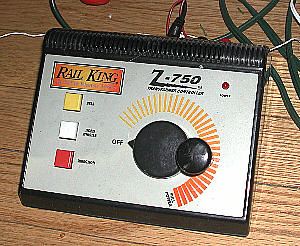
This modern transformer is typical of most old and new designs. A knob, dial or handle controls speed, while buttons control direction and the whistle or horn.
If you need a new transformer, here are companies who make them:
AC ( for O / O27, Standard and S): MTH, K-Line, Lionel, MRC (O27 series)
DC: Atlas, MRC, Lifelike, Bachmann.
Because the voltage in trains is low, risks are lower. That is not a license to be careless. Even low voltage can cause fire and injury. If you turn on the juice and the locomotive, an accessory or something else starts smoking, pull the plug on it. Turn off the power!
Avoid short circuits and other problems. You can find information on wiring on our website, under the basic manuals for your scale.
The best place to get help is the local model railroading club. Find a club that runs the same gauge trains as those you have. The NMRA lists clubs by region. It can save you time, trouble and expense to visit the club and ask their advice. Have them look over your trains. Most clubs have experienced persons who can evaluate trains and repair them.
No club? Try a hobby shop with a good reputation that offers repair services.
(Note that the All Gauge Model Railroading Page does not offer repair services nor evaluations of any toy or model train. We're a source of general information.)
Many believe that all old trains are worth plenty of money. In actuality, only a few are. Most are not all that rare, and so do not command too much of a price. You can buy guides to help you evaluate your trains. I advise against calling the folks who post ads it the paper reading "We buy old trains." Most of them won't give you anything near the value of what you have.
The trains that have any value are mostly O, Standard and S Gauge: Lionel, American Flyer and long-gone companies like Ives and Dorfan. Marx does not command high prices, and the Lionel "Scout" sets are virtually value-less. Forget making a profit from old HO or N. A Tyco train is worth less now than when it was made.
Buy the book...and before you think of selling, consider the value of the trains as a family heirloom. Many have sold old sets, only to later regret parting with a holiday tradition.
Will my post-1945 Lionel work with modern Lionel? Will my pre-1942 Lionel work with modern Lionel?
Your Postwar Lionel will work with modern O Gauge by Lionel, Williams, MTH / Railking, K-Line and Weaver. The couplers will work together. Pre-1942 Lionel can run on modern track, but the couplers will not mate with the post-1945 / modern knuckle coupler.
Will all my Marx be compatible?
To a point. Marx used four different coupler systems. They can all use the same track, etc. They just cannot all couple together. However, the tab of a tab-and-slot coupler can be fitted into the Marx knuckle coupler. Also, many tilt couplers have a slot toward the rear that will take a tab coupler. Otherwise, all Marx trains from any era can run on tubular rail and Marx switches and accessories.

The Lionel coupler on the far left has been the accepted standard for O Gauge since 1946. The others are Marx type, and all are incompatible with each other. At center is the Marx tilt coupler. At far right is the Marx knuckle coupler.
Is all HO the same?
Pretty much. There were a few early Lionel sets that ran on AC, but other than that, it all runs on DC on the same track. The only problem you may have is couplers. Until the mid-1990s, ready-to-run HO trains came with the old X-24 coupler. New HO has a knuckle-type coupler. Couplers on HO trains can easily be changed. It ought not be a problem for you.
Modern Replacement Parts for Old Trains:
Track, Switches (Turnouts) and Track Accessories (pins, joiners):
Lionel and K-Line make tubular track for O and O27. Both also make switches, crossovers and operating/ remote sections.
Atlas is the foremost maker of solid-profile HO and N track. Bachmann makes EZ-Track, which is mounted on roadbed yet will mate with older track types.
Aristocraft and LGB make G / #1 track
K-Line makes tubular S track. Modern S track is available from American Models and S Helper Service
Transformers:
Lionel, MTH, K-Line and MRC make AC transformers for Standard / Wide, O / O27 and S Gauge trains.
MRC, Atlas and Bachmann make transformers for HO and N gauge
Aristocraft, MRC, Marklin, LGB and Bachmann make transformers for #1 Gauge / G Gauge
Wiring Accessories: (Wire, clips, controllers, etc.)
Lionel, K-Line, MTH and Atlas O make wiring accessories for O / O27 and Standard / Wide Gauge. Many of these can also be used for American Flyer S Gauge.
American Models and S Helper Service make wiring accessories for S Gauge.
Atlas makes wiring accessories for HO, N and other two-rail DC systems.
Aristocraft makes wiring accessories for #1 / G.
Replacement Parts
K-Line and Lionel make replacements / repair parts, trucks and couplers for O / O27
Atlas makes replacement parts for HO and N
Kadee makes trucks and replacement parts for HO, S and O Scale (not 3-rail O)
Aristocraft makes couplers, trucks and replacement parts for G
Click here to return to All Gauge Model Railroading main page